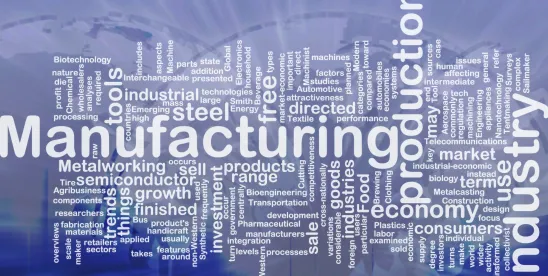Manufacturers considering new or expanded U.S. operations should review the plethora of financial incentives available at the federal, state, and local levels. As national economic policy aims to reshore domestic manufacturing, states and localities are eager to attract manufacturers and secure high-impact projects for their communities.
Incentive programs include tax credits as well as direct grants that can materially impact project economics, reduce the cost of facility development, enable equipment acquisition, and provide workforce training. Understanding how to navigate, negotiate, and stack these offerings can be the difference between a good deal and a transformative one.
Federal Tax Credits
On the federal level, we often target the underutilized New Markets Tax Credit (NMTC) program. Designed to spur private investment in economically distressed communities, the now-permanently authorized federal NMTC program is a powerful tool for manufacturers seeking to secure affordable financing to subsidize expansion of operations, acquire or modernize equipment, or boost working capital with job-creating investments.
At its core, the NMTC program provides investors with a federal tax credit spread over seven years. Community Development Entities (CDEs) allocate the $5 billion in tax credits each year in exchange for qualified investments. Manufacturers expanding their facilities or purchasing new equipment in qualifying census tracts should take advantage of below-market, flexible financing from NMTC-enhanced loans or equity-like capital with favorable terms including longer interest-only periods, lower rates, or subordinated debt structures. The indirect financing structure and tax credit investment often bridges financing gaps that traditional lenders may otherwise hesitate to fund. On average, they result in a net benefit of about 20% capital subsidy for each qualified project at the end of the seven-year compliance period.
To be eligible, manufacturers’ expansion projects must be located in a qualified low-income community and meet certain community impact standards. Many industrial zones across the U.S. meet these requirements, making manufacturers prime candidates. While community impact standards may vary among the allocating CDEs for each project, emphasis on job creation and quality, innovative technologies, revitalization and rural development and other similar benefits to the local community are key drivers to a manufacturer’s success in receiving awards under the program. NMTC financing requires careful structuring and coordination with CDEs, tax credit investors, and project lenders. However, when properly executed, the benefits are significant: enhanced liquidity, lower borrowing costs, and long-term growth in underserved areas.
State Incentives
States continue to expand their offerings and offer a myriad of programs to capture manufacturers’ reshoring investment. States are competing to attract and retain manufacturing operations in their states and businesses should consider these programs when scouring capital investment.
There are two types of incentives – statutory incentives and discretionary incentives. Statutory incentives, such as tax credits for research and development activities, are fixed and do not require advance application or approval from the state. These types of tax credits, which may or may not be refundable, are usually provided regardless of industry, with excess credits permitted to be carryforward to future tax periods. Discretionary incentives are those that are legislatively approved and often require application and approval from a states’ incentive authority. Our focus is on discretionary incentives.
Types of Discretionary Incentives Offered
Discretionary incentives are generally funded by: states accessing federal programs, like Community Development Block Grants; an appropriation by a state economic development agency from an established program; or from a direct state budget appropriation. Local jurisdictions may also be authorized to provide incentives, which are usually funded by a return of taxes paid, or an abatement of tax. Most large projects will qualify for a stack of incentives that layer benefits.
The sums committed by states can be staggering – Michigan has offered up to $6.2 billion in benefits to attract a semiconductor manufacturer, and states will often provide grants that exceed $100,000 per new job created. The race is on for states to develop attraction programs while the federal government is pushing foreign manufacturers to invest in U.S. facilities.
The type of activities which qualify for incentives include:
- Acquisition of real estate for new construction as well as leasing of existing facilities
- Construction of improvements
- Rehabilitation of existing facilities to modernize and/or increase production or efficiency
- Purchase and installation of machinery and equipment and related support items
- Training of employees
- Research and development activities
- Warehousing and logistics
Below are the primary programs offered by the states. The particulars vary state-to-state, with some states more heavily incentivizing activities in key sectors, such as clean energy, high tech manufacturing, agriculture and life sciences. Other states incentivize based on geographic location within the state, with a focus on increasing employment in areas of high unemployment. Generally speaking, states offer the four types of discretionary incentive programs.
Enterprise Zones Type Programs
Enterprise zone programs leverage benefits based on the amount of investment in a project and the new jobs, or jobs to be retained. Eligible projects require a minimum investment and creation of a minimum number of full-time jobs. Benefits are usually scaled based on total investment and job creation. These programs include a variety of benefits, such as:
- Grants – direct payments
- Forgivable Loans – upon completion of milestones achieved
- Refund of employee withholding taxes on new jobs
- Exemption from sales tax on construction materials (based on the prevailing state sales tax rate, 6% – 8.75%)
- Utility rate reductions
- Utility tax exemptions
- Construction jobs refundable tax credits
- Sales tax exemption for machinery, equipment and other personal property used in manufacturing facilities.
Historically, grant funding would often come at the outset of a project to assist in project launch. Many programs have transitioned to a post-performance model to reduce the risk to funding and eliminate the potential for “clawbacks” (repayment) if the project fails to meet agreed upon targets which are based on the amount of investment and the new (or retained) jobs created.
Depending on the program, advanced funding may be possible for ordering long-lead machinery and equipment.
Businesses located within state specific enterprise zones may also be eligible for:
- Property tax exemptions for machinery and equipment/pollution control facilities.
- Utility tax exemption for gas, electricity and similar excise charges.
Workforce Incentives
Workforce development programs are typically designed to reimburse businesses for eligible training activities or to provide training via a public-private partnership. As with all incentives, tracking the training activities and relevant expenditures is critical to capture reimbursements.
Qualified training includes classroom training, on-the-job training, seminars, workshops, pre-packaged training courses, and related workforce development instruction, including:
- Withholding tax credits for job creation and training.
- Reduction and/or elimination of local income tax withholding and payroll taxes.
Local Incentives
Counties and municipalities have varying authority and discretion to develop their incentive portfolio, but they, like states, are clamoring for manufacturers’ attention.
The leading incentive used by localities is tax incremental financing (TIF). TIF leverages anticipated future property tax revenues to support the financing of a project. Funds are generated by growth in the Equalized Assessed Valuation (EAV) of properties within locally designated districts over a period of years. Businesses utilize the revenues generated by their investment as memorialized in redevelopment agreements that are subject to approval by the local governing authority. Payments are typically provided in bi-annual installments following a project’s completion. Upfront funding may be available if the community agrees to issue bonds for the anticipated increase in EAV.
Development costs that may be eligible for TIF include:
- Surveys and BEA assessments
- Site preparation
- Building rehabilitation
- Fixtures and leasehold improvements
- Financing costs
In addition to TIFs, localities have also provided the following for new build or expansion projects:
- Local sales tax exemptions on eligible equipment
- Property tax abatements (real and personal property)
- Infrastructure support (roads, water, power).
Strategic Considerations
Foley’s attorneys and Public Policy & Government Relations team secure incentives and credits across jurisdictions by combining strategic planning, legislative advocacy, and direct engagement with state and local authorities. To assist clients’ expansion projects, Foley recently supported the passage of state legislation expanding the use of Tax Incremental Districts (TIDs) in Texas, which enables clients to fund infrastructure improvements and operational costs. Foley also played a key role in securing a state sales and use tax exemption for equipment and software purchases—providing immediate and material savings for their new facility expansion.
Programs like TIDs and Enterprise Zones have proven instrumental in funding public road access, utility upgrades, and other critical infrastructure for clients, while delivering substantial tax benefits tied to job creation and capital investment.
To fully realize these advantages, manufacturers must understand the legal and operational commitments tied to each incentive. Milestone revisions, while often possible, require proactive engagement with the governing jurisdiction. Annual compliance and reporting are also essential, particularly as incentive terms age and institutional knowledge at the project site may fade. Tracking both the promised benefits and the actual receipt of funds is key to avoiding clawbacks.
Finally, the structure and duration of the incentive term deserves close attention. Shorter benefit periods may offer greater business flexibility and reduce exposure to repayment risk. With thoughtful front-end planning and dedicated compliance protocols, manufacturers can maximize the value of these programs throughout the life of the incentive.
The opportunity is clear: federal, state, and local governments are focused on investing in U.S. manufacturing. Manufacturers who strategically plan and structure their projects accordingly can capture millions in benefits—and position themselves for long-term success in the U.S. market.




 />i
/>i

